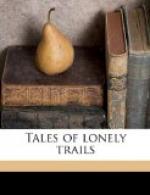When I returned to camp Nielsen had gone to bed and the fire had burned low. I threw on some branches of sage. The fire blazed up. But it seemed different from other camp-fires. No cheer, no glow, no sparkle! Perhaps it was owing to scant and poor wood. Still I thought it was owing as much to the place. The sadness, the loneliness, the desolateness of this place weighed upon the camp-fire the same as it did upon my heart.
We got up at five-thirty. At dawn the sky was a cold leaden gray, with a dull gold and rose in the east. A hard wind, eager and nipping, blew up the canyon. At six o’clock the sky brightened somewhat and the day did not promise so threatening.
An hour later we broke camp. Traveling in the early morning was pleasant and we made good time down the winding canyon, arriving at Furnace Creek about noon, where we halted to rest. This stream of warm water flowed down from a gully that headed up in the Funeral Mountains. It had a disagreeable taste, somewhat acrid and soapy. A green thicket of brush was indeed welcome to the eye. It consisted of a rank coarse kind of grass, and arrowweed, mesquite, and tamarack. The last named bore a pink fuzzy blossom, not unlike pussy-willow, which was quite fragrant. Here the deadness of the region seemed further enlivened by several small birds, speckled and gray, two ravens, and a hawk. They all appeared to be hunting food. On a ridge above Furnace Creek we came upon a spring of poison water. It was clear, sparkling, with a greenish cast, and it deposited a white crust on the margins. Nielsen, kicking around in the sand, unearthed a skull, bleached and yellow, yet evidently not so very old. Some thirsty wanderer had taken his last drink at that deceiving spring. The gruesome and the beautiful, the tragic and the sublime, go hand in hand down the naked shingle of this desolate desert.
While tramping around in the neighborhood of Furnace Creek I happened upon an old almost obliterated trail. It led toward the ridges of clay, and when I had climbed it a little ways I began to get an impression that the slopes on the other side must run down into a basin or canyon. So I climbed to the top.
The magnificent scenes of desert and mountain, like the splendid things of life, must be climbed for. In this instance I was suddenly and stunningly confronted by a yellow gulf of cone-shaped and fan-shaped ridges, all bare crinkly clay, of gold, of amber, of pink, of bronze, of cream, all tapering down to round-knobbed lower ridges, bleak and barren, yet wonderfully beautiful in their stark purity of denudation; until at last far down between two widely separated hills shone, dim and blue and ghastly, with shining white streaks like silver streams—the Valley of Death. Then beyond it climbed the league-long red slope, merging into the iron-buttressed base of the Panamint Range, and here line on line, and bulge on bulge rose the bold benches, and on up the unscalable outcroppings of rock, like colossal ribs of the earth, on and up the steep slopes to where their density of blue black color began to thin out with streaks of white, and thence upward to the last noble height, where the cold pure snow gleamed against the sky.




